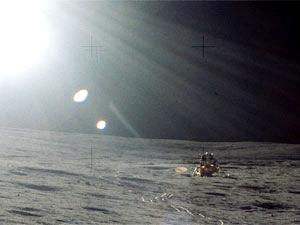Feature
Apollo's Lunar Leftovers
06.28.04
 By the time NASA's Apollo Program came to a close in December 1972, six crews of astronauts, six Apollo command modules, and more than 800 pounds of Moon rocks and lunar soil had been brought back to Earth. But some things were intentionally left behind.
By the time NASA's Apollo Program came to a close in December 1972, six crews of astronauts, six Apollo command modules, and more than 800 pounds of Moon rocks and lunar soil had been brought back to Earth. But some things were intentionally left behind.Image to left: The Eagle has landed. This photo of the Apollo 11 lunar module Eagle was taken by Commander Neil Armstrong. Credit: NASA
Apollos 11, 12 and 14 through 17 each landed successfully in a different region of the Moon, and evidence of our visit remains at each landing site. There are portions of six spindly Lunar Modules, three electric Lunar Roving Vehicles and an array of scientific instruments.
Weight limits forced so much material to be left on the Moon. "The more they threw out, the more rocks they could bring back," explained Stan Starr, deputy project director and chief engineer with Dynamac at NASA's Kennedy Space Center in Florida.
 The lower half of the Lunar Module (the descent stage) allowed the crew to land on the Moon and served as a launch pad when crews left the lunar surface. An American flag was implanted at each landing site, and commemorative plaques were affixed to one leg of each Lunar Module bearing the message that humans from Earth visited with peaceful intentions.
The lower half of the Lunar Module (the descent stage) allowed the crew to land on the Moon and served as a launch pad when crews left the lunar surface. An American flag was implanted at each landing site, and commemorative plaques were affixed to one leg of each Lunar Module bearing the message that humans from Earth visited with peaceful intentions.Image to right: Apollo 15 Commander Dave Scott took this picture of Lunar Module Pilot Jim Irwin near the Rover.
Credit: NASA
Apollo science was dedicated largely to lunar geology. Seismometers, instruments that detect and measure moonquakes and meteor impacts, were left by each lunar landing crew. Once they were no longer needed, the Lunar Module ascent stages were deliberately aimed at the lunar surface to provide scientists with a controlled seismic event. Other instruments monitored lunar gravity changes and temperatures beneath the surface. A wide variety of geological tools, such as long-handled scoops, core tubes and other gear also were discarded.
 The lunar crews even left behind most of their cameras, through which millions of people shared in these missions from Earth, and conserved space by bringing home only the film. Apollo 16 also left a gold-plated extreme ultraviolet telescope that performed the first astronomical observations from another heavenly body.
The lunar crews even left behind most of their cameras, through which millions of people shared in these missions from Earth, and conserved space by bringing home only the film. Apollo 16 also left a gold-plated extreme ultraviolet telescope that performed the first astronomical observations from another heavenly body.Image to left: Apollo 12 Lunar Module Pilot Alan Bean snaps a picture of Commander Pete Conrad, who in turn appears to be taking Bean's picture. Bean is visible in the center of Conrad's helmet visor. Credit: NASA
Apollos 11, 14 and 15 left behind Laser Ranging RetroReflectors that are still working after three decades. These arrays provide information about the distance to the Moon and how that distance expands over time. The reflectors are so small that aiming lasers at them from Earth is like using a rifle to hit a moving dime two miles away.
The astronauts had some fun, too. Alan Shepard, commander of Apollo 14, hit three golf balls that still remain in the Moon's Fra Mauro region. His first two shots didn't fare well, but his third swing sent the ball sailing for "miles and miles and miles," Shepard reported.
The nation's Vision for Space Exploration calls for NASA to return to the Moon as a stepping stone toward Mars and beyond. Could any of the abundant materials left on the Moon from the Apollo Program have any use?
 "Astronauts could potentially replace the batteries in the rovers and reuse them, if their gears and other moving parts are not full of dust," Starr said. "Perhaps they could recharge the oxygen and carbon dioxide scrubbers in the Apollo backpacks, or get some use out of the helmets and gloves. But after all this time on the surface, dust could have gotten into everything. Use of this equipment would require careful analysis and planning, since it wasn't designed to be reused."
"Astronauts could potentially replace the batteries in the rovers and reuse them, if their gears and other moving parts are not full of dust," Starr said. "Perhaps they could recharge the oxygen and carbon dioxide scrubbers in the Apollo backpacks, or get some use out of the helmets and gloves. But after all this time on the surface, dust could have gotten into everything. Use of this equipment would require careful analysis and planning, since it wasn't designed to be reused."Image to right: The sun shines brightly on the lunar surface and the Apollo 14 lunar module, Intrepid. Credit: NASA
In the meantime, the hardware we left behind will remain exactly where we left it, waiting in the dusty silence for us to return.
NASA's John F. Kennedy Space Center